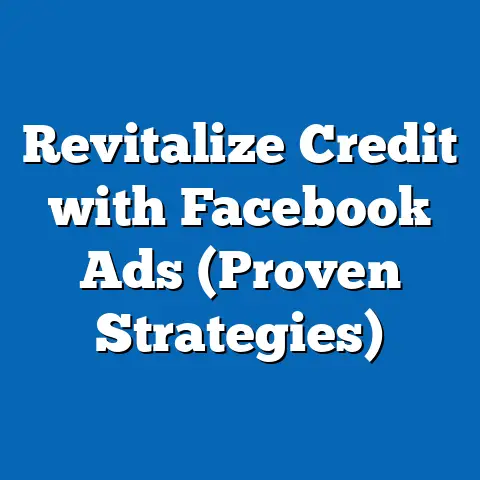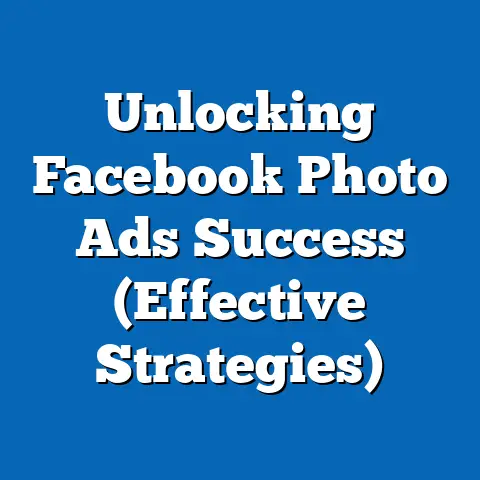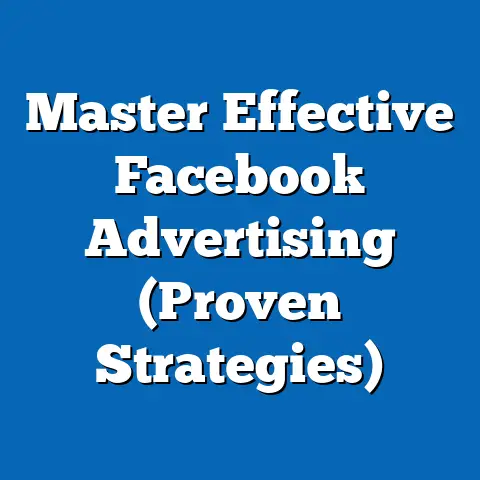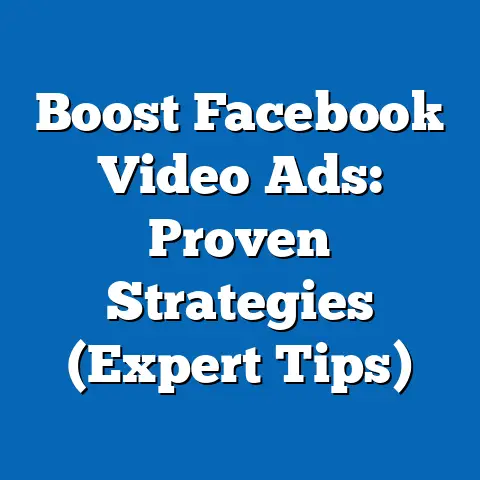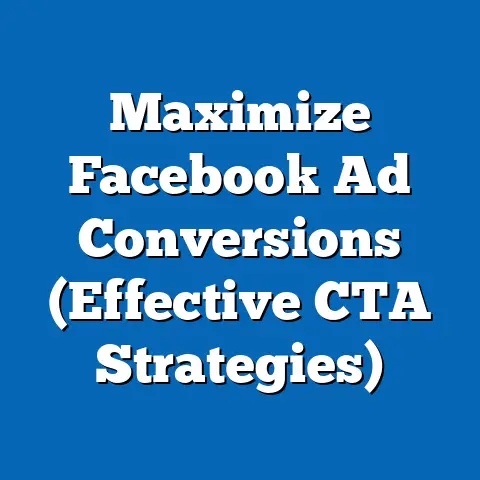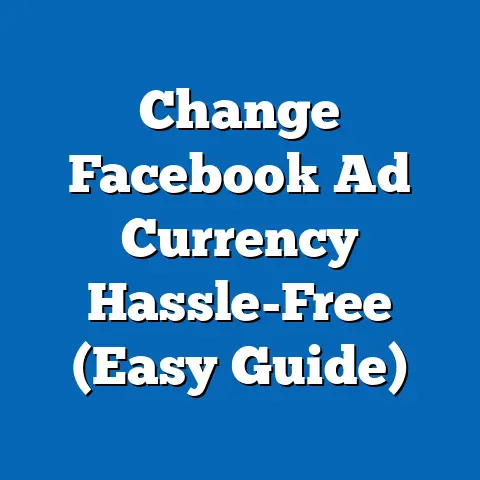Unlocking Poor Facebook Ad Delivery (Crucial Insights Revealed)
I remember the first time I poured my heart and soul (and a significant chunk of my budget) into a Facebook ad campaign. I was convinced I had the perfect product, a killer landing page, and ad creatives that would stop thumbs mid-scroll. I envisioned a surge of new customers, ringing cash registers, and the sweet taste of marketing victory. What I got instead was…crickets. A few likes, a handful of clicks, and a whole lot of wasted ad spend. It felt like shouting into a void.
This experience, unfortunately, isn’t unique. Many businesses, big and small, struggle with Facebook ad delivery. They create what they think is a perfect campaign, only to be met with disappointing results. The problem isn’t always a bad product or a terrible ad; often, it’s a misunderstanding of how Facebook actually delivers those ads to the right people.
In this guide, I’m going to pull back the curtain on Facebook ad delivery. I’ll share the insights I’ve gained from years of experience, both the victories and the hard-learned lessons, to help you diagnose and fix those frustrating ad delivery issues. We’ll dive into the mechanics of the algorithm, explore common pitfalls, analyze key metrics, and even peek into the future of Facebook advertising. Let’s turn those crickets into a symphony of conversions.
Understanding Facebook Ad Delivery
Facebook ad delivery, at its core, is the process by which Facebook decides which ads to show to which users and when. It’s not just about throwing money at the platform and hoping for the best. It’s about understanding the complex interplay of targeting, bidding, creative, and, most importantly, the Facebook algorithm.
Why is it so crucial? Because without proper delivery, your meticulously crafted ads will be seen by the wrong people (or nobody at all), resulting in wasted budget, missed opportunities, and a whole lot of frustration. Think of it like trying to sell snow shovels in Hawaii – no matter how great your shovels are, you’re targeting the wrong audience.
The Mechanics of Facebook Ad Delivery
Facebook’s ad delivery system is driven by an auction. When a user opens Facebook or Instagram, the platform мгновенно (instantly) runs an auction among all the ads that are eligible to be shown to that user. The winner of the auction gets to display their ad. This auction considers several factors:
- Your Bid: How much are you willing to pay to show your ad?
- Estimated Action Rates: How likely is the user to engage with your ad (click, like, convert, etc.)? This is heavily influenced by your ad’s relevance score.
- Ad Quality and Relevance: How well does your ad resonate with the target audience?
- User Value: How much value does Facebook believe your ad will provide to the user’s experience? (Ads that are annoying or misleading will be penalized).
Facebook’s goal isn’t just to maximize revenue; it’s also to provide a positive user experience. Ads that are irrelevant, low-quality, or disruptive can negatively impact the platform’s user base. Therefore, Facebook prioritizes ads that are both profitable and beneficial to its users.
The Facebook Advertising Ecosystem
To truly understand ad delivery, you need to grasp the broader Facebook advertising ecosystem. This includes:
- Facebook Ads Manager: The central hub for creating, managing, and analyzing your ad campaigns.
- Facebook Pixel: A piece of code you install on your website to track user actions and optimize your ads for conversions.
- Custom Audiences: Allow you to target specific groups of people based on their interactions with your business (e.g., website visitors, email subscribers, past purchasers).
- Lookalike Audiences: Enable you to find new people who are similar to your existing customers.
- Campaign Objectives: The specific goals you want to achieve with your ads (e.g., brand awareness, website traffic, lead generation, sales).
Understanding how these elements interact is key to crafting effective campaigns that are optimized for delivery. For example, if you’re running a conversion campaign without a properly installed Facebook Pixel, you’re essentially flying blind.
Takeaway: Facebook ad delivery is a complex process driven by an auction system that considers your bid, ad quality, and user value. Understanding the Facebook advertising ecosystem is essential for optimizing your campaigns for delivery.
Common Reasons for Poor Ad Delivery
Now, let’s get to the heart of the matter: why your Facebook ads might be underperforming. There are several common culprits, and identifying the root cause is the first step towards fixing the problem.
Audience Saturation
One of the most frequent reasons for poor ad delivery is audience saturation. This happens when you repeatedly show the same ads to the same audience, leading to ad fatigue. People get tired of seeing the same message over and over again, and they start to tune it out.
Think of it like listening to your favorite song on repeat. At first, you love it, but after a while, you get sick of it. The same principle applies to Facebook ads.
Signs of audience saturation:
- Decreasing click-through rates (CTR)
- Increasing cost per click (CPC)
- Decreasing engagement (likes, comments, shares)
- Increasing ad frequency
How to fix it:
- Expand your audience: Try targeting broader interests or demographics.
- Refresh your creatives: Create new ad images and copy to keep your ads fresh.
- Rotate your ads: Use multiple ad variations and rotate them regularly.
- Use frequency capping: Limit the number of times a person sees your ad within a given period.
I once ran a campaign for a local restaurant that was struggling with audience saturation. They were targeting a very specific geographic area with the same ad for months. I suggested expanding their targeting to include nearby towns and creating several new ad variations with different angles and offers. The results were immediate – CTR increased, CPC decreased, and the restaurant saw a significant boost in foot traffic.
Low Relevance Score
Your ad’s relevance score is a crucial indicator of how well your ad resonates with your target audience. Facebook assigns a relevance score (now called “ad relevance diagnostics”) based on factors like expected engagement and ad quality. A low relevance score means that your ad is not appealing to the people you’re targeting, and Facebook will penalize you by showing your ad less frequently and charging you more.
Signs of a low relevance score:
- Low engagement rates
- High cost per result
- Poor ad delivery
How to fix it:
- Improve your ad creative: Make sure your ad is visually appealing and relevant to your target audience.
- Refine your targeting: Ensure you’re targeting the right people with the right message.
- Test different ad variations: Experiment with different headlines, images, and copy to see what resonates best with your audience.
- Use high-quality images and videos: Avoid using blurry or unprofessional visuals.
I had a client who was running ads for a software product. Their ad creative was generic and didn’t speak to the specific pain points of their target audience. I worked with them to create new ad creatives that highlighted the unique benefits of their product and addressed the specific challenges their target audience faced. The result was a significant increase in their relevance score and a dramatic improvement in ad delivery.
Budget Constraints
Even with the best targeting and creative, an insufficient budget can severely limit your ad exposure, especially in competitive markets. Facebook’s algorithm needs enough budget to learn and optimize your campaign. If your budget is too low, the algorithm won’t have enough data to work with, and your ads will struggle to reach a significant portion of your target audience.
Signs of budget constraints:
- Low reach
- Limited impressions
- Slow delivery
How to fix it:
- Increase your budget: If possible, increase your daily or lifetime budget.
- Optimize your bidding strategy: Consider using cost caps or bid caps to control your spending.
- Focus on a smaller, more targeted audience: If you can’t afford to reach a large audience, focus on a smaller, more qualified group.
- Run your ads during peak hours: Experiment with different ad schedules to see when your target audience is most active.
I’ve seen countless businesses try to run Facebook ads on a shoestring budget, only to be disappointed with the results. While it’s possible to achieve some success with a small budget, you need to be realistic about your expectations. Investing in a sufficient budget is often necessary to achieve meaningful results.
Creative Issues
Your ad creative is the first thing people see, and it plays a crucial role in capturing their attention and driving engagement. Poor ad creatives can lead to low engagement rates, low relevance scores, and ultimately, poor ad delivery.
Signs of creative issues:
- Low click-through rate (CTR)
- High cost per click (CPC)
- Low engagement (likes, comments, shares)
How to fix it:
- Use high-quality images and videos: Avoid using blurry or unprofessional visuals.
- Write compelling ad copy: Highlight the benefits of your product or service and use a clear call to action.
- Make your ad visually appealing: Use eye-catching colors, fonts, and layouts.
- Test different ad formats: Experiment with different ad formats, such as image ads, video ads, carousel ads, and collection ads.
- Ensure your ad is mobile-friendly: Most Facebook users access the platform on their mobile devices, so make sure your ad looks good on a small screen.
I once worked with a clothing retailer whose ad creatives were outdated and unappealing. They were using the same generic product photos they had been using for years. I convinced them to invest in professional product photography and create new ad creatives that showcased their clothing in a more modern and stylish way. The result was a dramatic increase in their CTR and a significant boost in sales.
Takeaway: Poor ad delivery can be caused by audience saturation, low relevance scores, budget constraints, or creative issues. Identifying the root cause is the first step towards fixing the problem.
Analyzing Metrics to Diagnose Issues
To effectively diagnose and address ad delivery issues, you need to become fluent in the language of Facebook advertising metrics. These metrics provide valuable insights into how your ads are performing and where you can make improvements.
Impressions vs. Reach
- Impressions: The number of times your ad was displayed on the screen.
- Reach: The number of unique people who saw your ad.
Why it matters:
Impressions tell you how often your ad is being shown, while reach tells you how many different people are seeing it. If you have a high number of impressions but a low reach, it means you’re showing your ad to the same people repeatedly, which can lead to audience saturation.
Example:
Let’s say your ad has 10,000 impressions and a reach of 2,000. This means that, on average, each person saw your ad 5 times (10,000 impressions / 2,000 reach = 5). This could indicate that you’re targeting too narrow of an audience or that your ad frequency is too high.
Actionable insight:
If your impressions are significantly higher than your reach, consider expanding your audience or implementing frequency capping to avoid audience saturation.
Click-Through Rate (CTR)
- Click-Through Rate (CTR): The percentage of people who saw your ad and clicked on it.
Why it matters:
CTR is a key indicator of how engaging your ad is. A low CTR suggests that your ad is not resonating with your target audience.
Benchmark:
A good CTR varies depending on your industry and campaign objective, but a general benchmark is around 1-2%.
Example:
If your ad has 10,000 impressions and 100 clicks, your CTR is 1% (100 clicks / 10,000 impressions = 0.01 or 1%).
Actionable insight:
If your CTR is below the benchmark, consider improving your ad creative, refining your targeting, or testing different ad variations.
Frequency
- Frequency: The average number of times a person saw your ad.
Why it matters:
High frequency can signal audience fatigue. If people are seeing your ad too often, they’re likely to tune it out, which can lead to decreasing engagement and increasing costs.
Benchmark:
A good frequency depends on your campaign objective and target audience, but a general guideline is to keep it below 3-4.
Example:
If your ad has 10,000 impressions and a reach of 2,000, your frequency is 5 (10,000 impressions / 2,000 reach = 5).
Actionable insight:
If your frequency is too high, consider expanding your audience, refreshing your creatives, or implementing frequency capping.
Takeaway: Monitoring key metrics like impressions, reach, CTR, and frequency is crucial for diagnosing ad delivery issues and identifying areas for improvement.
Case Studies of Poor Delivery and Recovery
Let’s look at some real-world examples of businesses that faced poor ad delivery and how they turned things around.
Case Study 1: The Stagnant SaaS Startup
A SaaS startup, let’s call them “Innovate Software,” launched a Facebook ad campaign to generate leads for their new project management tool. They targeted small business owners with an interest in productivity and collaboration. Initially, the campaign performed well, generating a steady stream of leads at a reasonable cost. However, after a few weeks, the campaign started to decline. Lead volume decreased, cost per lead increased, and the overall ROI plummeted.
The Challenge:
Innovate Software was experiencing audience saturation. They had been targeting the same audience with the same ad for too long, and people were starting to tune it out.
The Solution:
- Lead volume increased by 40%.
- Cost per lead decreased by 25%.
- Overall ROI improved by 30%.
Key Insight:
Constantly monitor your audience reach and frequency to identify signs of audience saturation. Refresh your creatives and expand your targeting regularly to keep your ads fresh and engaging.
Case Study 2: The Misunderstood E-Commerce Brand
An e-commerce brand selling handmade jewelry, let’s call them “Artisan Gems,” launched a Facebook ad campaign to drive sales. They targeted women aged 25-54 with an interest in fashion and jewelry. However, their ads were not performing well. They had a low CTR, a high cost per click, and very few sales.
The Challenge:
Artisan Gems had a low relevance score. Their ad creative was not resonating with their target audience.
The Solution:
- Improved Ad Creative: Artisan Gems invested in professional product photography and created new ad creatives that showcased their jewelry in a more appealing way. They also highlighted the unique story behind their brand and the craftsmanship involved in creating their jewelry.
- Refined Targeting: They refined their targeting to focus on women who had previously engaged with their website or social media pages. They also created lookalike audiences based on their existing customers.
- Tested Different Ad Variations: They tested different headlines, images, and copy to see what resonated best with their audience.
The Results:
- CTR increased by 150%.
- Cost per click decreased by 50%.
- Sales increased by 200%.
Key Insight:
Pay close attention to your ad relevance score. If it’s low, it means your ad is not resonating with your target audience. Improve your ad creative and refine your targeting to increase your relevance score and improve ad delivery.
Takeaway: Case studies provide valuable insights into how to diagnose and address ad delivery issues. Learn from the experiences of other businesses and apply those lessons to your own campaigns.
The Role of Algorithms in Ad Delivery
Facebook’s algorithms are the invisible hand that guides ad delivery. They are constantly learning and adapting to user behavior, and they play a crucial role in determining which ads to show to which users.
How Facebook’s Algorithms Work
Facebook’s algorithms use machine learning to analyze vast amounts of data about users, ads, and the interactions between them. This data includes:
- User demographics: Age, gender, location, interests, etc.
- User behavior: Pages liked, groups joined, posts engaged with, etc.
- Ad performance: CTR, conversion rate, relevance score, etc.
Based on this data, the algorithms predict how likely a user is to engage with a particular ad. The higher the predicted engagement, the more likely the ad is to be shown to that user.
The Importance of Machine Learning
Machine learning is essential for Facebook’s ad delivery system because it allows the algorithms to continuously learn and improve over time. As more data becomes available, the algorithms become more accurate in their predictions, leading to better ad delivery and improved results for advertisers.
Aligning Your Ads with Facebook’s Algorithm
To improve your ad delivery performance, you need to align your ads with Facebook’s algorithm. This means:
- Creating high-quality, engaging ad creative: The algorithm prioritizes ads that are visually appealing and relevant to the target audience.
- Targeting the right audience: The algorithm uses user data to determine which ads are most likely to resonate with each user.
- Optimizing your bidding strategy: The algorithm considers your bid when deciding which ads to show.
- Providing a positive user experience: The algorithm penalizes ads that are annoying, misleading, or disruptive.
I’ve found that focusing on creating high-quality content that genuinely resonates with my target audience is the most effective way to align my ads with Facebook’s algorithm. When you prioritize user experience, the algorithm will reward you with better ad delivery and improved results.
Takeaway: Understanding how Facebook’s algorithms work is crucial for optimizing your ad campaigns for delivery. Focus on creating high-quality content, targeting the right audience, and providing a positive user experience.
Future Trends in Facebook Ad Delivery
The world of Facebook advertising is constantly evolving, and it’s important to stay ahead of the curve. Here are some emerging trends that may affect Facebook ad delivery in the future:
The Impact of Privacy Changes
Recent privacy changes, such as Apple’s App Tracking Transparency (ATT), have made it more difficult for Facebook to track user behavior and personalize ads. This has led to a decrease in ad targeting accuracy and an increase in the cost of advertising.
What it means for advertisers:
- You need to focus on building first-party data (data you collect directly from your customers).
- You need to rely more on contextual targeting (targeting based on the content users are viewing).
- You need to diversify your advertising channels.
The Rise of Video Content
Video content is becoming increasingly popular on Facebook, and it’s likely to play an even bigger role in ad delivery in the future. Video ads tend to be more engaging than image ads, and they can be used to tell compelling stories and connect with your audience on a deeper level.
What it means for advertisers:
- You need to invest in high-quality video production.
- You need to optimize your video ads for mobile devices.
- You need to experiment with different video ad formats, such as short-form videos, live videos, and interactive videos.
The Role of AI and Automation
AI and automation are already playing a significant role in Facebook advertising, and they’re likely to become even more important in the future. AI-powered tools can help you optimize your ad campaigns, automate repetitive tasks, and personalize ad experiences.
What it means for advertisers:
- You need to embrace AI-powered tools to improve your ad performance.
- You need to learn how to use automation to streamline your ad management process.
- You need to focus on creating personalized ad experiences that resonate with your target audience.
I believe that the future of Facebook advertising will be driven by data, AI, and personalization. Advertisers who can effectively leverage these technologies will be best positioned to succeed in the years to come.
Takeaway: Stay informed about emerging trends in Facebook advertising to adapt your strategies and stay ahead of the competition.
Conclusion
Unlocking the secrets of Facebook ad delivery is an ongoing journey, not a one-time fix. It requires a deep understanding of the platform, a willingness to experiment, and a commitment to continuous improvement.
Throughout this guide, I’ve shared the insights I’ve gained from years of experience, both the successes and the failures. I’ve explored the mechanics of Facebook’s ad delivery system, identified common pitfalls, analyzed key metrics, and peeked into the future of Facebook advertising.
The key takeaways are:
- Understand the algorithm: Facebook’s algorithm is the driving force behind ad delivery. Learn how it works and align your ads with its principles.
- Monitor your metrics: Pay close attention to key metrics like impressions, reach, CTR, and frequency to identify potential issues.
- Refine your targeting: Ensure you’re targeting the right people with the right message.
- Improve your creative: Create high-quality, engaging ad creative that resonates with your target audience.
- Stay informed: Keep up with the latest trends and best practices in Facebook advertising.
While challenges exist, they are not insurmountable. By understanding the intricacies of Facebook ad delivery and applying the insights I’ve shared in this guide, you can improve your ad performance, drive better results, and achieve your marketing goals. Now go out there and turn those crickets into a symphony of conversions!

